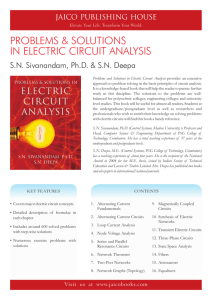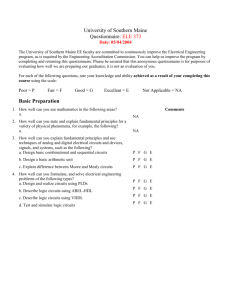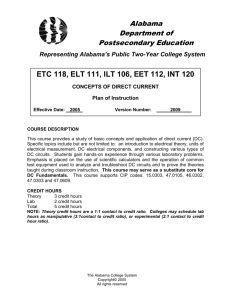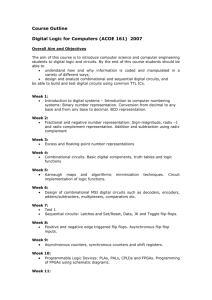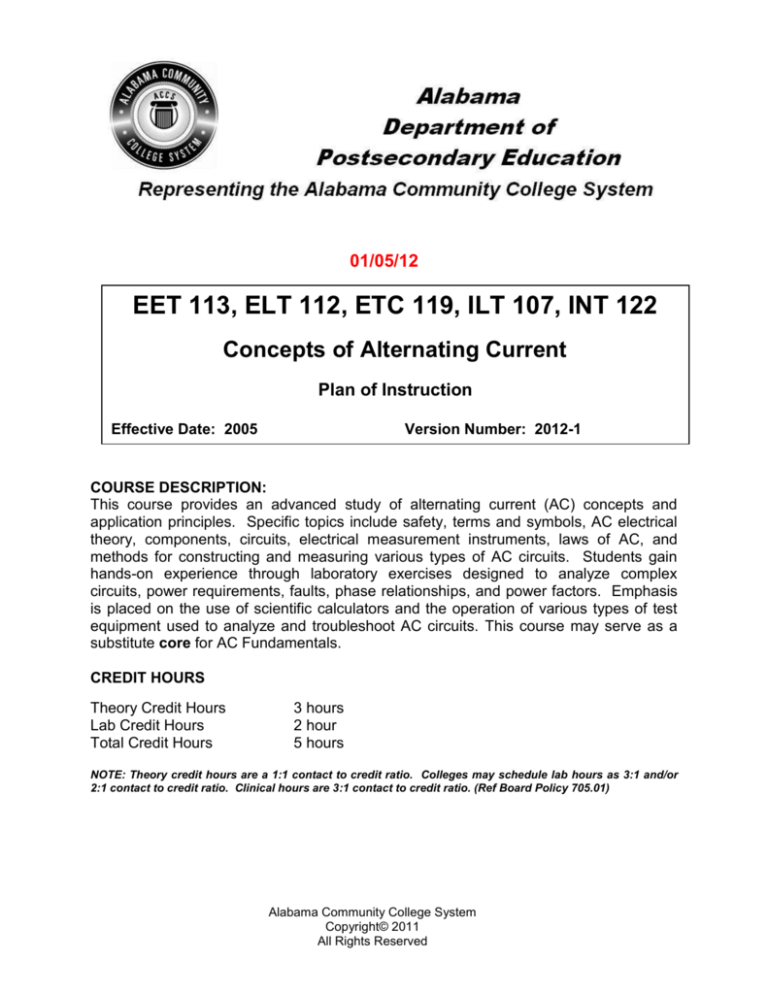
01/05/12
EET 113, ELT 112, ETC 119, ILT 107, INT 122
Concepts of Alternating Current
Plan of Instruction
Effective Date: 2005
Version Number: 2012-1
COURSE DESCRIPTION:
This course provides an advanced study of alternating current (AC) concepts and
application principles. Specific topics include safety, terms and symbols, AC electrical
theory, components, circuits, electrical measurement instruments, laws of AC, and
methods for constructing and measuring various types of AC circuits. Students gain
hands-on experience through laboratory exercises designed to analyze complex
circuits, power requirements, faults, phase relationships, and power factors. Emphasis
is placed on the use of scientific calculators and the operation of various types of test
equipment used to analyze and troubleshoot AC circuits. This course may serve as a
substitute core for AC Fundamentals.
CREDIT HOURS
Theory Credit Hours
Lab Credit Hours
Total Credit Hours
3 hours
2 hour
5 hours
NOTE: Theory credit hours are a 1:1 contact to credit ratio. Colleges may schedule lab hours as 3:1 and/or
2:1 contact to credit ratio. Clinical hours are 3:1 contact to credit ratio. (Ref Board Policy 705.01)
Alabama Community College System
Copyright© 2011
All Rights Reserved
Concepts of Alternating Current
EET 113, ELT 112, ETC 119, ILT 107, INT 122
PREREQUISITE COURSES
As determined by college.
CO-REQUISITE COURSES
As determined by college.
PROFESSIONAL COMPETENCIES
Practice safety.
Explain concepts related to AC electrical theory.
Use AC electrical measurement instruments.
Construct and analyze various AC circuits.
INSTRUCTIONAL GOALS
Cognitive – Comprehend principles and concepts related to the fundamentals of
alternating current.
Psychomotor – Apply principles of the fundamentals of alternating current.
Affective – Value the importance of adhering to policy and procedures related to
the fundamentals of alternating current.
STUDENT OBJECTIVES
Condition Statement: Unless otherwise indicated, evaluation of student’s attainment
of objectives is based on knowledge gained from this course. Specifications may be in
the form of, but not limited to, cognitive skills diagnostic instruments, manufacturer’s
specifications, technical orders, regulations, national and state codes, certification
agencies, locally developed lab/clinical assignments, or any combination of
specifications.
ACCS Copyright© 2011
All Rights Reserved
2
Concepts of Alternating Current
EET 113, ELT 112, ETC 119, ILT 107, INT 122
STUDENT LEARNING OUTCOMES
MODULE A – INTRODUCTION TO AC ELECTRICAL THEORY
MODULE DESCRIPTION – This module is designed to teach the students the concepts
related to AC electrical theory. Topics include magnetism, sine waves, Ohm’s law, and AC
power laws.
PROFESSIONAL COMPETENCIES
PERFORMANCE OBJECTIVES
KSA
A1.0 Practice safety.
A1.1 Perform lab activities in a safe
3
manner.
A1.2 Select and safely use the
3
appropriate tools.
A2.0 Explain concepts related to AC
electrical theory.
A2.1 This competency is measured
cognitively.
LEARNING OBJECTIVES
2
KSA
A1.1.1 Explain safety rules and procedures for lab activities.
A1.2.1 Explain the proper use of basic electrical tools.
A1.2.2 Explain inspection procedures for tools.
A2.1.1 Define terms associated with AC electricity.
A2.1.2 Identify basic symbols used with AC electricity.
A2.1.3 Explain magnetism.
A2.1.4 Explain magnetic units.
A2.1.5 Explain electromagnetic induction.
A2.1.6 Identify a sine wave.
A2.1.7 Describe sine wave generation.
A2.1.8 Define measurements of a sine wave.
A2.1.9 Analyze basic AC circuits using Ohm’s Law.
A2.1.10 Calculate sine wave measurements.
A2.1.11 Explain AC power law formulas.
A2.1.12 Calculate circuit values using AC power law.
MODULE A OUTLINE:
Safety and tool use
Terms
Symbols
Magnetism
Magnetism characteristics
Magnetic units
Electromagnetic induction
Sine wave measurements
Peak to peak
Peak
RMS
Average
Period
2
2
2
1
1
2
2
2
1
2
2
3
3
2
3
ACCS Copyright© 2011
All Rights Reserved
3
Concepts of Alternating Current
EET 113, ELT 112, ETC 119, ILT 107, INT 122
Frequency
AC Ohm’s Law
Formulas
Calculations
AC Power Law
Formulas
Calculations
MODULE B – AC ELECTRICAL MEASUREMENTS
MODULE DESCRIPTION – This module is designed to teach the students to use AC
electrical measurement instruments. Topics include components and operation of an
oscilloscope, and how it differs from other electrical measurement instruments.
PROFESSIONAL COMPETENCIES
PERFORMANCE OBJECTIVES
KSA
B1.0 Use AC electrical
B1.1 Use various instruments to
3
measurement instruments.
measure AC quantities.
LEARNING OBJECTIVES
B1.1.1 Identify components of an oscilloscope.
B1.1.2 Explain the operation of an oscilloscope.
B1.1.3 Differentiate between the measurements of an oscilloscope and other
electric measurement instruments.
MODULE B OUTLINE:
Oscilloscope
Multi-meter
Other devices
KSA
1
3
3
MODULE C – AC CIRCUITS
MODULE DESCRIPTION – The purpose of this module is to teach students to construct
and analyze various AC circuits. Topics include RC, RL, and RLC circuits, safety,
magnetism, sine waves, oscilloscopes, schematics, transformers, and troubleshooting.
PROFESSIONAL COMPETENCIES
PERFORMANCE OBJECTIVES
KSA
C1.0 Construct and analyze various C1.1 Construct RC circuits and
3
AC circuits.
measure electrical quantities.
C1.2 Construct RL circuits and measure
3
electrical quantities.
C1.3 Construct RLC circuits and
3
measure electrical quantities.
LEARNING OBJECTIVES
ACCS Copyright© 2011
All Rights Reserved
KSA
4
Concepts of Alternating Current
EET 113, ELT 112, ETC 119, ILT 107, INT 122
C1.1.1 Identify schematics and symbols for various AC circuits.
C1.1.2 Explain the characteristics of capacitors.
C1.1.3 Calculate total capacitance in series and parallel.
C1.1.4 Calculate capacitive reactance.
C1.1.5 Calculate impedance.
C1.1.6 Calculate phase angle.
C1.1.7 Calculate current.
C1.1.8 Calculate voltage.
C1.1.9 Calculate power factors.
C1.1.10 Calculate time constants.
C1.2.1 Explain the characteristics of inductors.
C1.2.2 Calculate total inductance in series and parallel.
C1.2.3 Calculate inductive reactance.
C1.2.4 Calculate impedance.
C1.2.5 Calculate phase angle.
C1.2.6 Calculate current.
C1.2.7 Calculate voltage.
C1.2.8 Calculate power factors.
C1.2.9 Calculate time constants.
C1.2.10 Explain the turns ratio of transformers.
C1.2.11 Define electrical characteristics of transformers.
C1.3.1 Calculate impedance.
C1.3.2 Calculate phase angle.
C1.3.3 Calculate current.
C1.3.4 Calculate voltage.
C1.3.5 Calculate power factors.
C1.3.6 Calculate resonance.
C1.3.7 Describe filters.
C1.3.8 Measure bandwidth.
MODULE C OUTLINE:
Schematics and symbols
Capacitive circuits
Capacitive reactance
Inductive circuits
Inductive reactance
Transformers
Turns ratio
Primary/secondary
Electrical characteristics
Resistive, capacitive, inductive circuits
Time constants
RC
LR
Resonant circuits
Types and functions of filters
1
2
3
3
3
3
3
3
3
3
2
3
3
3
3
3
3
3
3
2
2
3
3
3
3
3
3
2
3
ACCS Copyright© 2011
All Rights Reserved
5
Concepts of Alternating Current
EET 113, ELT 112, ETC 119, ILT 107, INT 122
Measurement and calculations
Circuit construction techniques
Troubleshooting
LEARNING OUTCOMES TABLE OF SPECIFICATIONS
The table below identifies the percentage of learning objectives for each module.
Instructors should develop sufficient numbers of test items at the appropriate
level of evaluation.
Limited
Knowledge and
Proficiency
KSA
Module A
Module B
Module C
ACCS Copyright© 2011
All Rights Reserved
1
20%
33%
3%
Moderate
Knowledge
and
Proficiency
2
60%
0%
17%
Advanced
Knowledge
and
Proficiency
3
20%
67%
80%
Superior
Knowledge
and
Proficiency
4
6
Concepts of Alternating Current
Indicator
1
2
3
4
EET 113, ELT 112, ETC 119, ILT 107, INT 122
Learner’s Knowledge, Skills and Abilities
Key Terms
Description
Identifies basic facts and terms about the subject or
competency.
Limited
Knowledge Performs simple tasks associated with the
and
competency. Needs to be told or shown how to do
Proficiency
most tasks.
Requires close supervision.
Identifies relationship of basic facts and states
general principles and can determine step-by-step
Moderate
procedures for doing the competency.
Knowledge
and
Performs most parts of the competency. Needs help
Proficiency
only on hardest parts.
Requires limited supervision.
Analyzes facts and principles and draws conclusions
about the subject to include why and when the
Advanced
competency must be done and why each step is
Knowledge
needed. Can predict outcomes.
and
Performs all parts of the competency. Needs only a
Proficiency
spot check of completed work.
Requires little or no direct supervision.
Can evaluate conditions and make appropriate
Superior
decisions as related to resolving problems.
Knowledge
Performs competency quickly and accurately with no
and
direct supervision and is able to instruct and
Proficiency
supervise others.
ACCS Copyright© 2011
All Rights Reserved
7

